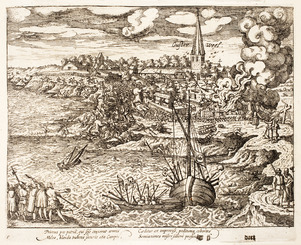Battle of Oosterweel facts for kids
Quick facts for kids Battle of Oosterweel |
|||||||
|---|---|---|---|---|---|---|---|
| Part of the Eighty Years' War | |||||||
 Battle of Oosterweel From Pieter Bor's Nederlantsche Oorloghen |
|||||||
|
|||||||
| Belligerents | |||||||
| Commanders and leaders | |||||||
| Jean Marnix † | Philip de Lannoy, Seigneur De Beauvoir |
||||||
| Strength | |||||||
| 2,500 | 800 | ||||||
| Casualties and losses | |||||||
| "Almost the entire force killed or captured" | Unknown | ||||||
The Battle of Oosterweel happened on March 13, 1567. It took place near the village of Oosterweel, close to Antwerp in what is now Belgium. Many historians see this battle as the start of the Eighty Years' War. During the battle, a Spanish army of paid soldiers surprised a group of rebels. Almost all the rebels were killed or captured.
Contents
Why the Battle Happened
Beginning in 1566, groups of Protestants in the Netherlands started breaking Catholic art and statues. This event is known as the Beeldenstorm (Image Storm). They were protesting against high taxes and strict rules on religion. These rules were set by Philip II of Spain, who was the ruler of the Habsburg Netherlands.
In March 1567, a young nobleman named Jean Marnix led a group of rebels. They gathered and built a strong camp at Oosterweel. This camp was about one mile from Antwerp.
The Battle Begins
To stop the rebels, Margaret of Parma, the Spanish governor of the Habsburg Netherlands, sent an army. This army was made up of paid soldiers, also called mercenaries. Many of these soldiers were provided by Count Egmont, who was loyal to Spain.
The army was led by Philip de Lannoy, Seigneur De Beauvoir. He was the commander of the governor's personal guards.
On March 12, the Spanish army secretly got ready for the fight. Their group of 800 men split into smaller teams. They quietly moved into position. Soldiers were given their helmets, small shields (bucklers), guns (arquebuses), body armor (corselets), and spears. They also got their flags and drums, but kept them quiet.
Before sunrise on March 13, the soldiers were told to advance quietly. They were not to show their flags or beat their drums. Once they saw the rebels, they were told to fire their guns all at once.
When the battle started, the rebels were completely surprised. Jean Marnix showed courage, but most rebels panicked. They shot their weapons wildly without aiming. The Spanish soldiers easily broke into the rebel camp. They killed hundreds of rebels and made many more run away.
After winning the battle, the Spanish soldiers hunted down the rebels who had fled. Jean Marnix was among those who were killed. Very few rebels escaped. Those who were captured were later put to death.
In the nearby city of Antwerp, William the Silent was the city's leader. He tried to stop Protestants from Antwerp who wanted to help the rebels. He said he had promised to support Philip II. Most citizens who tried to help the rebels quickly turned back. They saw how strong and fierce the Spanish soldiers were.
What Happened After
This defeat made the Calvinists stop openly challenging Spanish rule. Calvinist religious services across the Netherlands were affected. Many people who disagreed with Spanish rule, including William the Silent, left the country.
In Books
The battle and what happened afterward are shown in a book by Cecelia Holland. Her novel The Sea Beggars tells the story through the eyes of a young Calvinist from Antwerp. He tries to join the rebels but arrives too late.
Images for kids
See also
 In Spanish: Batalla de Oosterweel para niños
In Spanish: Batalla de Oosterweel para niños



